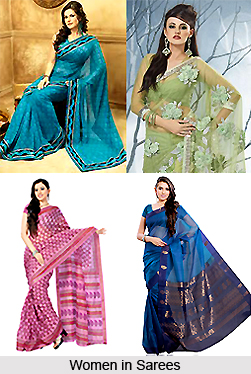Sarees and Indian Women have such an inextricable bond that words fall short to express the enigma. Sarees have earned the appellation as well as the sobriquet of exceptionality because of the stupendous use of fabrics and the convoluted designs. These designs are either derived from the scenes of ancient scriptures of the Mahabharata and the Ramayana or some motifs that are related to the mundane and daily rustic life.
 Sarees have adorned Indian Women since time immemorial. Indian sarees are categorized region wise as the choice, availability and culture differs from one another.
Sarees have adorned Indian Women since time immemorial. Indian sarees are categorized region wise as the choice, availability and culture differs from one another.
Indian Sarees have past through ages and seen the changing auras of time. As Mughal Age came and went sarees changed their essence and have been adaptable to the demands of age. Modern Indian Sarees are the effects of globalization; the costumes synthesize the cultural face of modern India. Traditional Indian Sarees speak in volumes about the Indian mass culture and the allied ways of life, the customs, the folk ways and point to the world the tale of a nation that submerges itself into bygone traditions though keeping at par with the ongoing winds of globalization.
Though the history of Indian sarees depicts that previously the sarees were hand-woven using silk or cotton as raw materials, now the weavers create different materials and the sarees are designed with excellent creativity. In the western part of India, people use sarees that are decorated with mixing many bright hues together with metallic thread (zari or jari) embroidery, and often include sparkling embellishments such as tinsel, sequins and mirrors. Apart from these, block-printing, tie-dye, etc are incorporated into the weaving and decorating styles of the region. The artisans of this region create sarees that are hugely used for traditional occasions and social gatherings as well. The end pieces of some traditional sarees have no kalga or buta at all, just repeated rows of bel and geometric bands, with or without a jhaalar embellishing either side. Some sarees, especially those worn by tribal and poor low-caste groups, traditionally had no obvious end piece at all. The intricacy and fineness of the blocks and overall quality of the workmanship are considered to be the creative excellence of the artisans. The sarees symbolize the status of the women in each region and the intricacy and designs with quality fabric are worn by the upper class women.
On the other hand, women of lower class wear sarees that are of inferior quality. Sarees like muslins of Alwar (Rajasthan), which were printed or brush-dyed in different colours on each face of the fabric, the fine translucent muslins called masuria malmal, Kota`s transparent muslins (often called Kota saris) etc are sarees worn by the upper class women of West India. Apart from these, West India is the abode of excellent Chanderi Sarees, Embroidered Tinsel Sarees, Gujarati Brocade Sarees, Maheswari Sarees, Paithani Sarees, Patola Saris, Tussar Sarees etc.
Georgette Sarees is one of the widely used sarees in India. These particular sarees have gained popularity for the light fabric. Exclusive georgette saree is essentially a party wear or a festive wear. These sarees are available in vibrant colours and are sometimes embellished with beads and zari work. The georgette sarees have become a style statement and are widely used for the gorgeousness. Though silk has occupied a distinct and important position in Indian Saree tradition, georgette sarees have made a mark in the Indian saree segment in recent times. The artisans have now concentrating on creating exclusive designs using georgette as the base. The stitches and the intricate workmanship used in pure georgette deserve admiration.





















